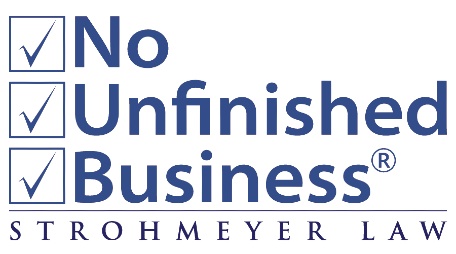10 Ideas for Year-End Tax Savings in 2022
As we near the end of 2022, there are certain things we can can be doing (or at least be aware of) to help lighten the upcoming tax burden before the year is over.
Ten Ways to Save on That Tax Bill This Year
Bear in mind, you should absolutely talk with your advisors before employing any of these, as your situation is unique, and you may have unintended consequences from any of these with regards to your tax bill. Now, disclaimer aside, let’s get started.
1. Tax-Free Income Accumulation or Withdrawals with Roth IRAs
You can take a tax-free qualified withdrawal from a Roth IRA if you’ve had one for over 5 years, and you’ve reached age 59 1/2 or are disabled. Alternatively, you are also exempted from Required Minimum Distribution (RMD) rules that affect traditional IRAs, so you can leave your Roth IRA untouched and leave it to your heirs if you don’t need it.
2. Tax-Free IRA Withdrawals on Top of Tax-Free Social Security
Between 50 percent and 100 percent of Social Security benefits can be tax-free for folks with modest incomes. If you are in that category, you might also have some otherwise taxable withdrawals taken from your traditional IRA.
Luckily, you can shelter all or part of those withdrawals from federal income tax with your standard deduction. For 2022, the basic standard deductions amounts are $12,950 (single), $19,400 (head of household), and $25,900 (married, filing jointly).
If you’re age 65 or older as of year-end, the standard deduction amounts are a bit higher. The point is, a good chunk (or maybe all) of your Social Security benefits might be federal- income-tax-free. Ditto for otherwise taxable withdrawals from your traditional IRA.
3. Tax-Free Home Sale Gains
In one of the best tax-saving deals ever, an unmarried seller of a principal residence can exclude (that is, pay no federal income tax on) up to $250,000 of gain, and a married joint-filing couple can exclude up to $500,000 of gain. After the huge surge in residential real estate prices, this break can be more valuable than ever. Naturally, there are some limitations, and you must pass certain ownership and use tests to qualify.
4. Tax-Free Capital Gains and Dividends
If you occupy the sweet spot, the federal income tax rate on long-term capital gains and qualified dividends is 0 percent. The surprising truth is, you can have a pretty healthy income and still be within the 0 percent bracket for long-term gains and dividends, based on your taxable income. For instance:
Say you’re a married joint-filer with two dependent kids in 2022. You claim the $25,900 standard deduction. You could have up to $109,250 of adjusted gross income, including long-term gains and dividends, and still be within the 0 percent bracket. ($109,250 – $25,900 = $83,350 of taxable income, which is the top of the 0 percent capital gains tax bracket for joint-filers in 2022.)
5. Capital Gains Sheltered with Capital Losses Are Tax-Free
Have you incurred capital losses from stocks and mutual fund investments held in a taxable brokerage firm account this year? If so, you’re not alone. The stock market has been crazy. Thankfully, capital losses are not all bad. If you have a current-year net capital loss and/or a capital loss carryover into this year, you can use it to shelter capital gains plus up to $3,000 of income from other sources (salary, self-employment income, interest income, whatever). You can carry over any unused net capital loss into next year to shelter gains and income in 2023 and beyond.
Schedule a free consultation with Strohmeyer Law to protect your family with an estate plan.
6. Tax-Free Treatment for Inherited Capital Gain Assets
If you inherit a capital gain asset, such as stock or mutual fund shares or real estate, the federal- income-tax basis of the asset is stepped up to its fair market value as of the date of your benefactor’s demise (or six months after that date, if the estate executor so chooses). So, if you sell the inherited asset, you won’t owe any federal capital gains tax except on appreciation that occurs after the magic date.
7. Tax-Free Section 1031 Real Estate Exchanges
Section 1031 of our beloved Internal Revenue Code allows you to postpone the federal income tax bill from unloading appreciated real property by arranging for a Section 1031 exchange, also known as a “like-kind exchange.” This time-honored maneuver is one big reason that some real estate investors have struck it rich over the years, because it keeps Uncle Sam out of their pockets.
Here’s the big tax-saving bonus: If you pass away while still owning real property that you’ve acquired in a Section 1031 exchange, the tax basis of the property is stepped up to fair market value as explained immediately above. Thus, now, the 1031 deferred gain turns into a tax-free gain.
8. Tax-Free Small Business Stock Gains
Qualified small business corporations (QSBCs) are a special category of corporation, the stock of which can potentially qualify for federal-income-tax-free treatment when you sell for a gain.
As the tax law currently stands, QSBC shares issued after September 27, 2010, are eligible for a 100 percent gain exclusion, which equates to totally federal-income-tax-free treatment if you hold the shares for over five years before selling. Ask your CPA or financial advisor about this.
9. Using Section 529 College Savings Plans
Section 529 college savings plan accounts also allow earnings to accumulate free of any federal income tax. The big selling point is that 529 accounts allow folks who can afford to make bigger contributions to get their college savings programs off the ground in a hurry. Then when the account beneficiary (typically your child or grandchild) reaches college age, tax-free withdrawals can be taken to cover higher education expenses. State income tax breaks are often available too.
Contributions to a 529 account will also reduce your taxable estate (if you’re worried about that), because the contributions are treated as gifts to the account beneficiary. Contributions in 2022 are eligible for the $16,000 annual federal gift tax exclusion. Contributions up to that amount won’t diminish your unified federal gift and estate tax exemption.
The unified exemption for 2022 will be $12.06 million, or effectively $24.12 million for a married couple. If you’re feeling more generous, you can make a larger lump-sum contribution and spread it over five years for gift tax purposes. That allows you to immediately benefit from five years’ worth of annual gift tax exclusions while jump- starting the beneficiary’s college fund.
10. Tax-Free Withdrawals from Coverdell Education Savings Accounts (CESAs)
You can contribute up to $2,000 annually to a Coverdell Education Savings Account (CESA) set up for a beneficiary who has not reached age 18. CESA earnings are allowed to accumulate federal-income-tax-free. Then tax-free withdrawals can be taken to pay for the beneficiary’s college tuition, fees, books, supplies, and room and board. If you have several beneficiaries in mind, you can contribute up to $2,000 annually to separate CESAs set up for each one.
In Summary
When it comes to tax planning, tax-free tops the list. If you would like to discuss any of these tax-free income sources as part of your larger plan, click here to get on our team’s calendar for a call.
End-of-Year Strategies for Irrevocable Gifting Trusts
As the year draws to a close, there are some crucial actions to take with an irrevocable gifting trust.
What to Do If You Receive an IRS Letter
Receiving a letter from the IRS might send shivers down your spine. So what's your first step? Is it always a cause for alarm? Let's walk through what you should do.
Why You Need a Trademark
We'll explain the the four main areas of intellectual property for business owners, why trademarks are crucial, and how to get your marks registered.





